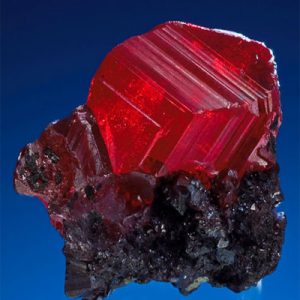Cuprite
Cuprite is a very uncommon and beautiful gem with a really high refractive index, adamantine luster and deep color that is red. Gem grade crystals mostly come from one location: Onganja mine, Namibia. Prior to this find, Cuprite gems were almost non-existant. You will find several other locations but crystals are usually tiny. Most crystals in the market from Onganja are obtained by mineral collectors and are not used to cut gems. This makes gems that are cuprite rarer.
Cuprite is commonly discovered as an oxidation product of copper sulphides in top of the areas of veins and sometimes connected with Azurite, Chalcocite, Native Copper, Limonite and Malachite. A form that is fibrous of is recognized as Chalcotrichite. Cuprite crystals and gems can be so deep red as to check almost black but when properly lit can show a truely amazing ruby or blood color that is red.
Cuprite was named in 1845 by Wilhelm Karl von Haidinger from the Latin term cuprum, meaning copper, in allusion to its composition. Haidinger renamed a formerly known mineral that had been known by way of a variety that is wide of. The reference that is earliest to Cuprite may have been around in 1546 by the German name Lebererzkupfer, meaning liver ore copper. Other names being previous: Hepatinerz (of Breithaupt), Kupferglas, Ruberite, Ruby Copper and Ziegelerz.
Cuprite distribution: a localities that are few fine specimens include: at Bogoslovsk, Nizhni Tagil, and Yekaterinburg (Sverdlovsk), Ural Mountains, Russia. At Dzhezkazgan, Kazakhstan. In England, fine crystals from numerous mines in Cornwall. At Rheinbreitbach, North Rhine-Westphalia, Germany. In Namibia, large crystals from the Onganja mine, 60 kilometer northeast of Windhoek, and at Tsumeb. At Likasi, Ruwe, additionally the Mashamba West mine, Kolwezi, Katanga Province, Congo (Shaba Province, Zaire). In america, in Arizona, large crystals from Bisbee, Cochise County, at Ray, Pinal County, Globe, Gila County, and elsewhere; from Santa Rita, Grant County, New Mexico. From Boleo, Baja California, Mexico. At Chuquicamata, Antofagasta, Chile. In Australia, from Broken Hill and Cobar, New South Wales; at Burra-Burra and Moonta, South Australia; large crystals in the Red Dome mine, Chilliago, Queensland.
| Category: | Oxide mineral |
| Chemical Formula: | Cu2O |
| Copper Oxide | |
| Molecular Weight: | 143.09 gm |
| Composition: | Copper | 88.82 % | Cu | 100.00 % | Cu2O |
| Oxygen | 11.18 % | O | |||
| 100.00 % | 100.00 % | = TOTAL OXIDE |
| Crystallography: | Isometric – Hexoctahedral |
| Crystal Habit: | As cubic, octahedral, and dodecahedral crystals, to 14 cm, which may be highly modified; as hairlike capillary forms, with square section, reticulated, tufted and matted; also earthy, compact granular, massive. |
| Twinning: | Penetration twins common |
| Cleavage: | Interrupted on {111}, more rarely on {001} |
| Fracture: | Conchoidal, irregular/uneven |
| Tenacity: | Brittle |
| Moh’s Hardness: | 3.5 – 4.0; Vickers: VHN100=183 – 222 kg/mm2 |
| Density: | 6.14 g/cm3 (measured) |
| Luminescence: | None |
| Radioactivity: | Not Radioactive |
| Color: | Cochineal-red, ruby-red, purplish red, to nearly black; in transmitted light, cochineal-red or red in thick sections; yellow-orange, yellow, lemon-yellow in progressively thinner sections; in reflected light, gray blue, commonly with many red internal reflections |
| Transparency: | Transparent to translucent |
| Luster: | Adamantine to submetallic, earthy |
| Refractive Index: | 2.849 Isotropic |
| Birefringence: | 0.000 (Isotropic) |
| Dispersion: | n/a |
| Pleochroism: | Anomalous, common |
| Anisotropism: | Anomalously anisotropic. Color in reflected light: bluish white. Internal reflections: blood-red. |


